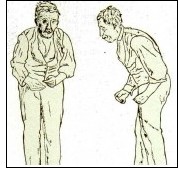
 |
The disease starts when specialized nerve cells in an important section of the midbrain gradually die off. Their death leaves a gap in the information chain between the brain and muscles. “Alpha-synuclein was the first Parkinson’s disease gene to be identified. That was the breakthrough,” said Professor Thomas Gasser from the Hertie Institute for Clinical Brain Research. Today, six years later, about a dozen such genes have been identified – for instance, the DJ-1 gene. It contains the blueprint for a protein that neutralizes toxic oxygen compounds. Such toxic oxygen molecules damage the cell membrane, proteins and DNA if they are not eliminated in time by the detoxification mechanism of the cell. Dj-1 is an important component of this detox mechanism.
In some Parkinson’s patients, the cause of illness is already known. They have inherited a damaged alpha-synuclein gene from their parents, and with it, Parkinson’s disease. This gene produces “sick” alpha-synuclein proteins thatagglutinate and kill off the surrounding nerve cells.
NGFN scientist Dr. Philipp Kahle and his research team made an important discovery: because a letter of the genetic code has been changed in the blueprint of the DJ-1 gene, a protein forms that lacks the stability of the healthy protein.
To elucidate this, the scientists carried out the following experiment:
They introduced the modified DJ1 gene into cultured nerve cells and compared these cells to those which contained the healthy, unmodified DJ1 gene. Soon they noticed that the modified DJ1 protein has a significantly shorter life span than the comparable, healthy protein.
Currently it is not clear whether the protein disintegrates on its own or whether it is broken down by certain tools of the cell. However, most likely the rapid disintegration is linked to Parkinson’s disease. Perhaps the nerve cells die off because they cannot dispose of the toxic oxygen compounds swiftly enough when the unstable DJ1 in their detoxication equipment disintegrates too quickly.
Page 2: There are few hereditary forms – Parkinson’s usually occurs sporadically.




